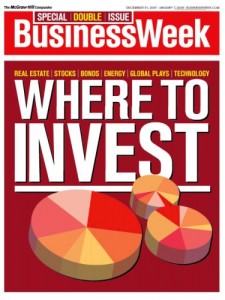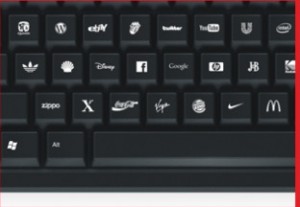Gannett gave the industry some welcome good news by posting quarterly results that actually exceeded expectations. In the wake of three layoffs of steadily increasing scope over the past year, conventional wisdom was that Gannett would lay a stinker on investors when it reported earnings this week. Instead, its stated results of 46 cents per share beat Wall Street expectations by nearly a dime. “Demand seems to be firming up a bit in some categories and in some geographic locations,” the CFO said.
Maybe those results are a harbinger of better times, because it looks like advertising spending is going to drop 2% next year. That would ordinarily be terrible news, but in 2009 it’s cause for celebration. That’s because ad spending is off 14.5% this year and 18% in the second quarter alone, the worst showing since the Marx Brothers were movie marquis headliners. The new estimates come from Magna, a unit of the Interpublic Group and a closely-watched monitor of advertising activity. The forecaster expects growth to resume in the second half of 2011 but to expand at an anemic 1% annually through 2014. Online advertising – particularly search – will lead the way, although local TV, national cable and outdoor venues will also grow. Not surprisingly, the big losers are newspapers (3.7% annual decline through 2014) and magazines (3.3% over the same period). Magna’s Brian Wieser says the newspaper industry is in “terminal decline.”
Buy BusinessWeek For Less Than a Copy of BusinessWeek
 Have you always wanted to own a newsweekly? Well, you can buy BusinessWeek for $1. If that sounds like a bargain, keep in mind that the magazine is reportedly set to lose $75 million this year. That’s down from profits of up to $100 million during the dot-com boom. Times certainly have changed.
Have you always wanted to own a newsweekly? Well, you can buy BusinessWeek for $1. If that sounds like a bargain, keep in mind that the magazine is reportedly set to lose $75 million this year. That’s down from profits of up to $100 million during the dot-com boom. Times certainly have changed.
Alan Mutter’s prescription is for BW to niche itself at the high end, doing deals with peddlers of pricey Wall Street reports that funnel subscribers their way. He also suggests that the magazine could become the ultimate destination for crowd-sourced financial information, since there are so many smart people out there who want to give advice. His ideas would be plausible if they didn’t involve completely reinventing the culture and the brand at a business that’s hemorrhaging money right now. Perhaps a buyer could effect that transformation by firing 90% of the staff and starting over. There’s also the small problem of the complete irrelevance of a weekly in a world that can barely even support dailies any more.
However, Alan M. Webber thinks BW is a steal at $1. The Fast Company co-founding editor thinks the title is perfectly positioned to become the American foil to The Economist, which seems to be doing just fine these days. “BW could bring fresh energy, opinion, and perspective to all of the change in business that is so hard to make sense of,” he enthuses on Huffington Post. So what are you waiting for, Alan? Just a buck.
Shirky on Journalism’s Future: Put Down the Phone!
Clay Shirky may not always come up with breakthrough ideas, but he has an uncanny ability to derive sensible trends from apparent chaos. Read Shirky’s views on the future of journalism from the Cato Institute. His basic insight: journalism as we’ve know it has long been supported by advertising inefficiencies that made it possible for coupon clippers and automobile buyers to fund journalism that they didn’t personally care about.
The Internet has removed so much inefficiency from the market that these subsidies are no longer viable, so journalism must find sustainable new models. Shirky sees three: crowdsourcing or “participatory” journalism, database mining and patronage.
Working journalists might be most interested in his description of Off the Bus, a Huffington Post venture that monitored polling places using a crowdsourced model last year and achieved remarkable success. Off the Bus couldn’t have worked without a dedicated team of behind-the-scenes editors who made sense of reports filtering in from across the country. That’s journalism, but it’s not what Shirky terms “the ‘phone call’ model of reporting — one paid journalist talking to one source at a time.” Instead, the journalist is an organizer and interpreter.
Shirky also likes the database-driven style of journalism practiced at The Smoking Gun, which mines public documents and databases for insights. Again, the idea that journalism requires phone calls and reportorial shoe leather is losing relevance in an age when shoe leather is becoming free.
Miscellany
San Diego Weekly Reader and the new owners of the San Diego Union-Tribune are engaged in a vicious battle over allegations by former employees of U-T owner Platinum Equity Partners that the investment firm engaged in ritual acts of sexual harassment, including sex-for-favors and hush-money payments.
The dispute originated from lawsuits filed anonymously by three former employees in 2007, which were ultimately dismissed. Reader describes the allegations in detail and also republishes a lengthy warning shot letter by a Los Angeles lawyer called “Mad Dog” Singer that threats all kinds of terrible consequences if Reader goes ahead with its story (which it did) or publishes Singer’s letter (which it also did). The dispute tarnishes some of the shine on Platinum, whose rescue of the U-T staved off possible closure of the paper. The Reader also tells of Platinum’s latest venture: to take over bankrupt auto-parts maker Delphi Corporation with help from General Motors and Federal bailout money.
Mark S. Luckie has been running 10,000 Words for nearly two years now and he celebrates the liberation of unemployment in an uplifting essay entitled “Why being an unemployed journalist is the best thing to ever happen [sic] to me.” Luckie celebrates his layoff last December as a chance to redouble his efforts to become a multimedia journalist and do the blog right. He also praises other grass-roots efforts by former employees of the East Valley Tribune and the Newark Star-Ledger as evidence that “all the talk of journalism dying is hooey.” Several unemployed journos contribute supportive comments about their own reinvention, but one notes that Luckie fails to address a basic question that also occurred to us: how is he making a living?
 Last week’s demise of The Printed Blog evidently didn’t put the final nail in the blogs-in-print coffin. A UK startup called The Blog Paper is taking a run at the same idea. It’s inviting bloggers to submit their stuff to a community ratings machine that will determine which entries are most print-worthy. Co-founder Anton von Waldburg thinks this Digg-like functionality is distinctive as he repeatedly tells Online Journalism Blog. One of the most highly-rated entries on the site today is an idea to put advertising on keyboards (right). Good luck with all that.
Last week’s demise of The Printed Blog evidently didn’t put the final nail in the blogs-in-print coffin. A UK startup called The Blog Paper is taking a run at the same idea. It’s inviting bloggers to submit their stuff to a community ratings machine that will determine which entries are most print-worthy. Co-founder Anton von Waldburg thinks this Digg-like functionality is distinctive as he repeatedly tells Online Journalism Blog. One of the most highly-rated entries on the site today is an idea to put advertising on keyboards (right). Good luck with all that.
Two upstate New York newspapers have dropped a day from their publishing schedules. The Tonawanda News cut its Monday edition and will now publish Tuesday through Saturday. The Medina Journal-Register eliminated its Tuesday edition and now publishes four days a week.
Did you know that 4,000 bloggers contribute to Huffington Post, all of them for free? Michelle Haimoff cites this statistic in a HuffPo column proposing a rewards system for bloggers. Haimoff says her proposal is a way to “create a sustainable business model in the long term,” but we think getting people like John Kerry and Larry David to write for free is a pretty good model to begin with.
Comments
This entry was posted on Thursday, July 16th, 2009 at 9:43 am and is filed under Facebook, Fake News, Google, Hyper-local. You can follow any responses to this entry through the RSS 2.0 feed. Both comments and pings are currently closed.



The HuffPost is going back to the roots of journalism.
The people who write features for the HoffPost for free are, in fact, doing so to advance their own prestige in whatever community they want to apply it.
Before advertising got involved, there was only PR.
Now that advertising has “left the building” (except for introducing new products or old product to a new marketplace, and only if its going to prove amenable to the cost/benefit analyses) the role of media is going back to PR, or “earned advertising” (as opposed to “paid for advertising”) where the company has less control over the message that’s out there.
Unfortunately, the part of the equation that is getting the media corporations all a-twitter is the death of the “paid for” portion of the advertising model.
With careful coaching, a PR disaster (see: United Breaks Guitars http://www.youtube.com/watch?v=5YGc4zOqozo ) can be turned into a victory simply for the price of repairing a guitar.
Next, we’ll see these kinds of things STAGED for the PR buzz.
The HuffPost is a model for the future of journalism. Not all of it but a definite model for it.
Shrink wrappers…
MacDue provide complete turnkey production lines and really do have the most technologically advanced machinery of it’s type…